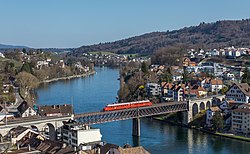Schaffhausen
Schaffhausen is a town in northern Switzerland and the capital of the canton of the same name. It has a population of about 36,000[1] as 2016.
 | |
Location of Schaffhausen
Lua error in Module:Infobox_mapframe at line 118: attempt to index field 'wikibase' (a nil value).
| |
| Coordinates: 47°42′N 8°38′E / 47.700°N 8.633°ECoordinates: 47°42′N 8°38′E / 47.700°N 8.633°E | |
| Country | Switzerland |
| Canton | Schaffhausen |
| District | (None in canton of Schaffhausen) |
| Government | |
| • Executive | Stadtrat with 5 members |
| • Mayor | Stadtpräsident (list) Peter Neukomm SP (as of January 2017) |
| • Parliament | Grosser Stadtrat with 36 members |
| Area | |
| • Total | 41.85 km2 (16.16 sq mi) |
| Elevation (Bahnhofstrasse) | 403 m (1,322 ft) |
| Population (December 2017) | |
| • Total | 36,332 |
| • Density | 868.15/km2 (2,248.49/sq mi) |
| Time zone | UTC+01:00 (Central European Time) |
| • Summer (DST) | UTC+02:00 (Central European Summer Time) |
| Postal code(s) | 8200, 8203, 8207, 8208, 8231 Hemmental |
| Localities | Schaffhausen, Breite, Gruben, Buchthalen, St. Niklausen, Herblingen, Hauental, Hemmental |
| Surrounded by | Beringen, Büsingen am Hochrhein (DE-BW), Büttenhardt, Dörflingen, Feuerthalen (ZH), Flurlingen (ZH), Merishausen, Neuhausen am Rheinfall, Stetten, Thayngen |
| Twin towns | Sindelfingen (Germany), Singen am Hohentwiel (Germany), Dobrich (Bulgaria) |
| Website | www Profile (in German), SFSO statistics |
Imperial City of Schaffhausen Reichsstadt Schaffhausen | |||||||||
|---|---|---|---|---|---|---|---|---|---|
| 1190 or 1218–1330 1415–1501 | |||||||||
| Status | Free Imperial City of the Holy Roman Empire | ||||||||
| Capital | Schaffhausen | ||||||||
| Government | Republic | ||||||||
| Historical era | Middle Ages | ||||||||
• | betw 1190 and 1218 | ||||||||
• Pledged to Habsburgs | 1330 | ||||||||
• Bought independence | 1415 | ||||||||
| 1454 | |||||||||
• | 1501 | ||||||||
| 1648 | |||||||||
| |||||||||
Imperial Abbey of All Saints in Schaffhausen Reichskloster Allerheiligen, Schaffhausen | |||||||||
|---|---|---|---|---|---|---|---|---|---|
| 1080–1529 | |||||||||
| Status | Imperial Abbey of the Holy Roman Empire | ||||||||
| Capital | Schaffhausen | ||||||||
| Government | Principality | ||||||||
| Historical era | Middle Ages | ||||||||
• Consecrated (Leo IX) | 22 November 1049 | ||||||||
• | 1080 | ||||||||
• Gained Hiltensweiler lands | 1122–1389 | ||||||||
| 1454 | |||||||||
• City joined Switz. | 1501 | ||||||||
• Converted to monastery and cathedral church | 1524 | ||||||||
• | 1529 | ||||||||
| |||||||||
The old portion of the town has many fine Renaissance era buildings decorated with exterior frescos and sculpture, as well as the impressive old canton fortress, the Munot. A train runs out of town to the nearby Rhine Falls in Neuhausen am Rheinfall, Europe's largest waterfall, a tourist attraction.
History
Schaffhausen was a city state in the Middle Ages, documented to have struck its own coins starting in 1045. For a time it was under Habsburg domination, but regained its independence in 1415. It allied itself with Zürich in 1457, and became a full member of the Swiss Confederation in 1501. The first railroad came to Schaffhausen in 1857.
Schaffhausen is in a finger of Swiss land surrounded on three sides by Germany. On April 1, 1944, Schaffhausen suffered a bombing raid by United States Army Air Forces aircraft which strayed from German airspace into neutral Switzerland. While the United States immediately offered four million dollars in reparations, the raid occurred only a month after the Swiss Air Force had shot down an American bomber.
In 1947 it merged with the former municipality of Buchthalen. In 1964 it merged with the former municipality of Herblingen. Since 2009, Hemmental has been part of the town.
Industry
Schaffhausen has some well-known industrial companies (Georg Fischer) in piping systems, machine tools and automotives, one internationally-reputed watches manufacturer (IWC), and drug industry (Cilag, founded by Bernhard Joos).
Schaffhausen Media
Looking upwards (eastwards), an SBB Red Arrow double railcar crossing the Feuerthalen Rhine bridge; Schaffhausen is on the left and Feuerthalen on the right; picture taken in April 2018 from the Munot castle
Aerial view by Walter Mittelholzer (1919)
Rhine Falls as seen from Neuhausen am Rheinfall
Trains waiting at Schaffhausen railway station
Trainspotting at Schaffhausen railway station
Urban bus routes of vbsh in the towns of Schaffhausen and Neuhausen am Rheinfall (as of December 2023)
Regional bus routes of vbsh in the canton of Schaffhausen and neighboring German territory (as of December 2023)
Battery electric bus at Bahnhofstrasse
Boat of URh near Dörflingen on the High Rhine
References
- ↑ "PX-Web - Datenbank wählen". www.pxweb.bfs.admin.ch. Archived from the original on 2017-10-10. Retrieved 2018-07-17.
Other websites
![]() Media related to Schaffhausen at Wikimedia Commons
Media related to Schaffhausen at Wikimedia Commons
- City of Schaffhausen Archived 2019-11-25 at the Wayback Machine (in German)
- Schaffhausen Tourism Archived 2007-10-13 at the Wayback Machine
- City archives Archived 2008-09-17 at the Wayback Machine (in German)
- U.S. Bombings of Switzerland during World War II Archived 2007-05-05 at the Wayback Machine









